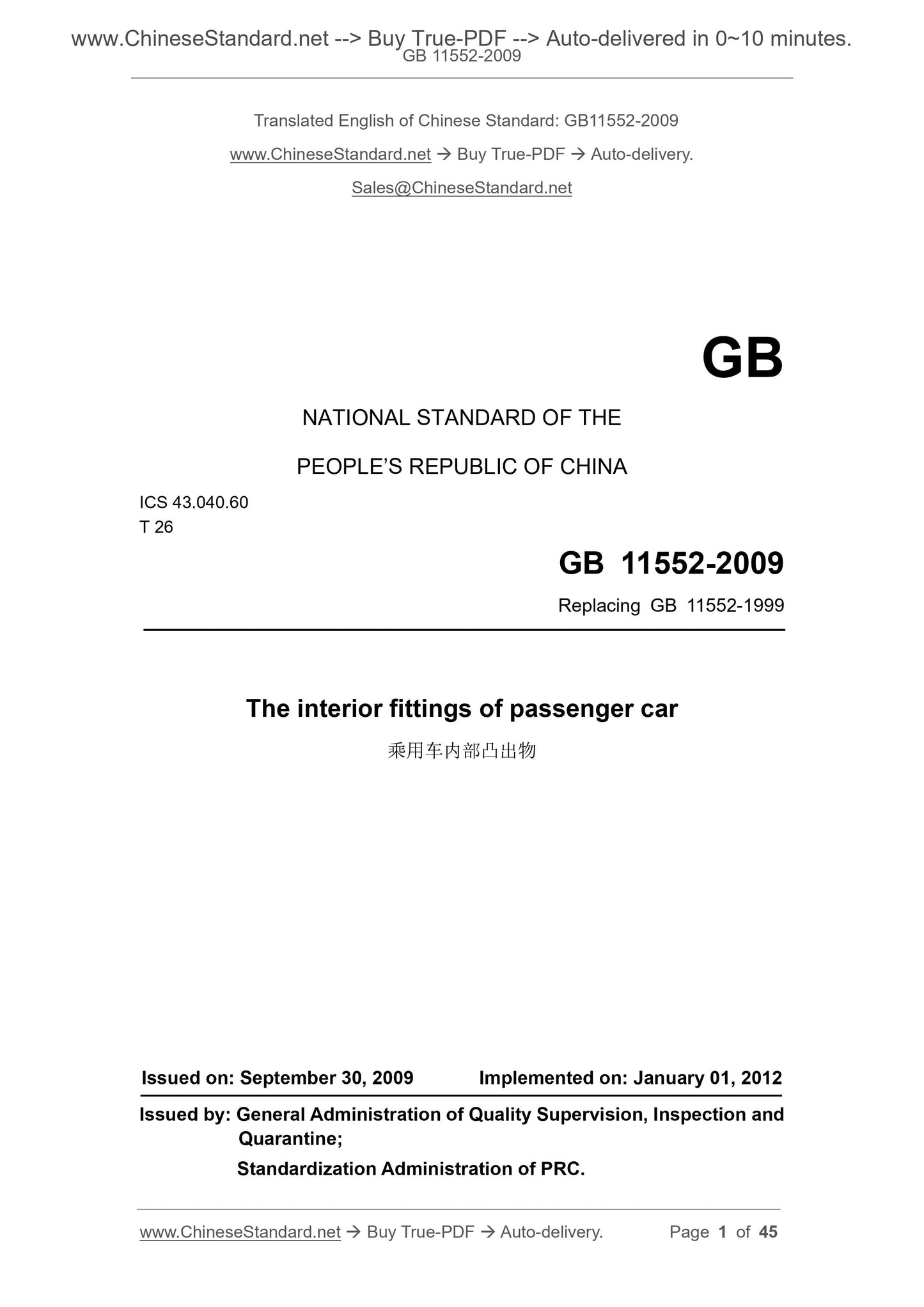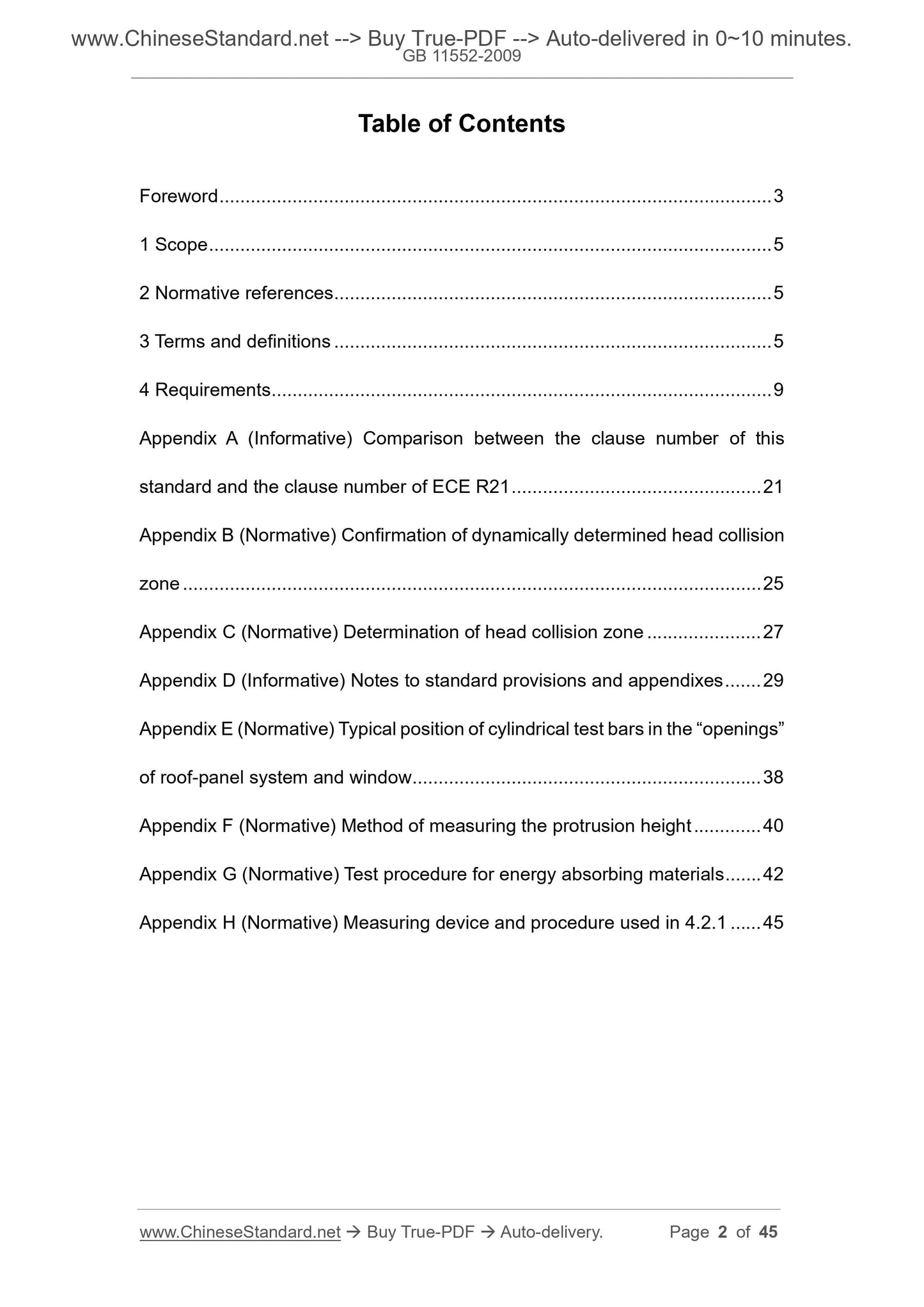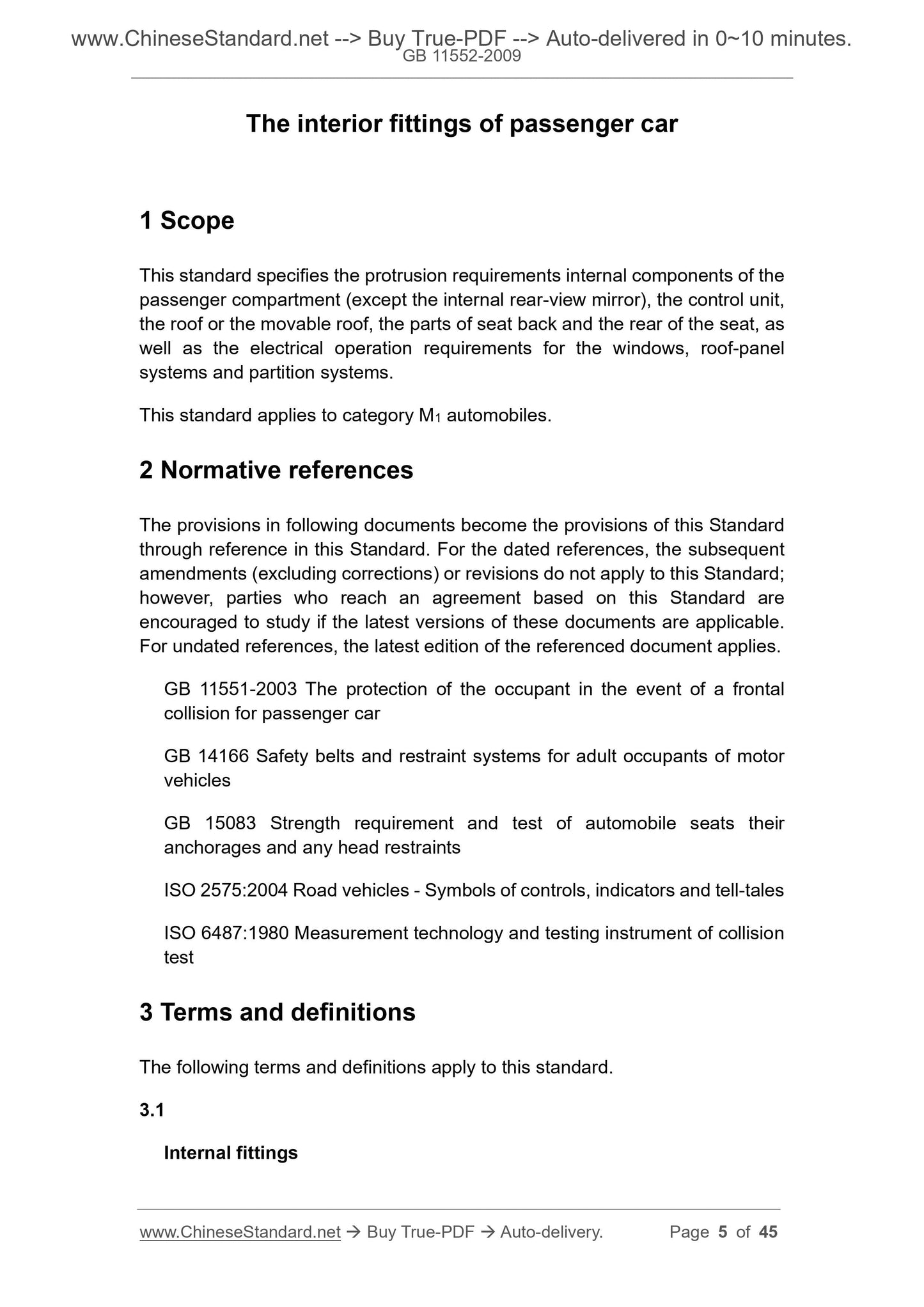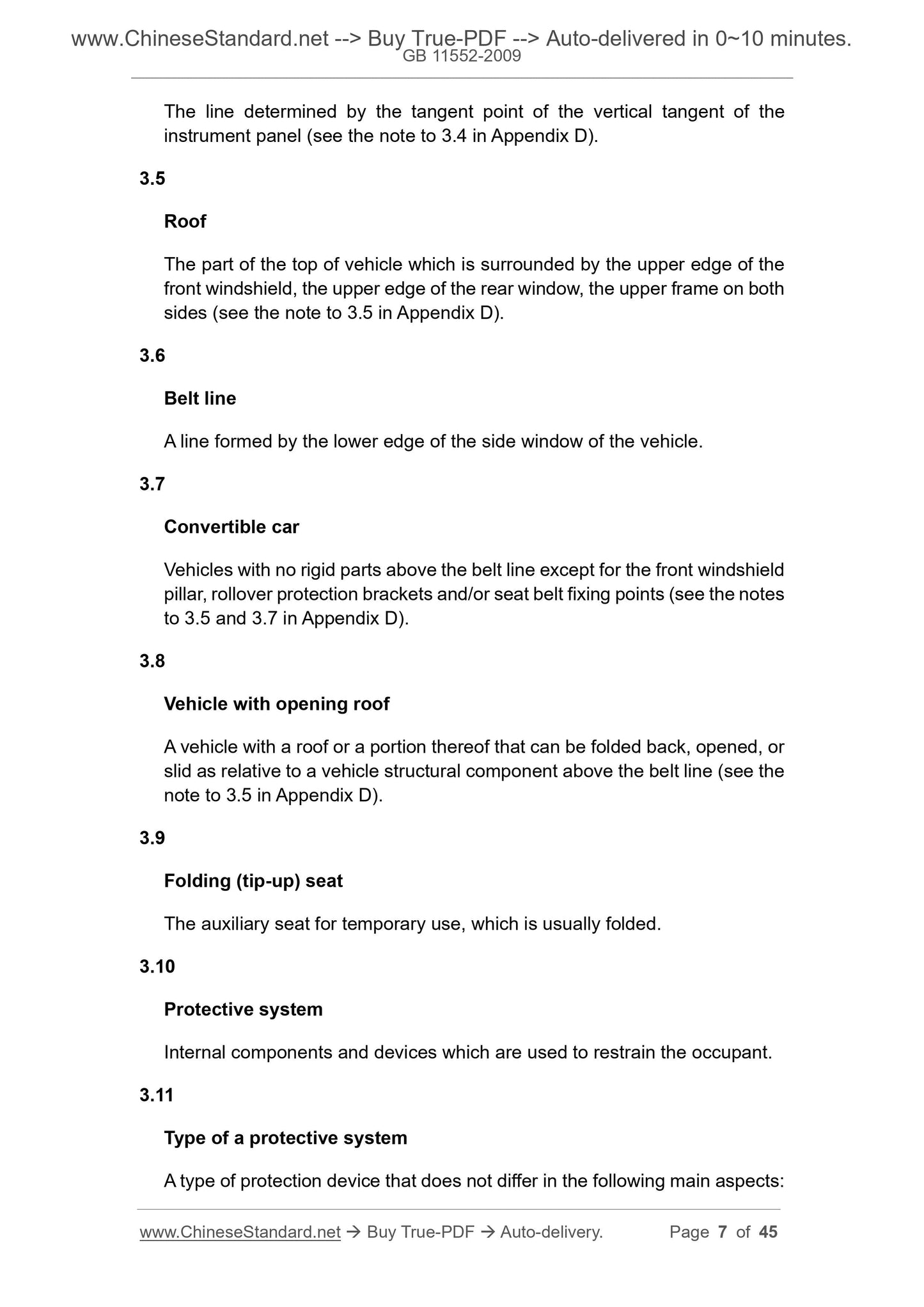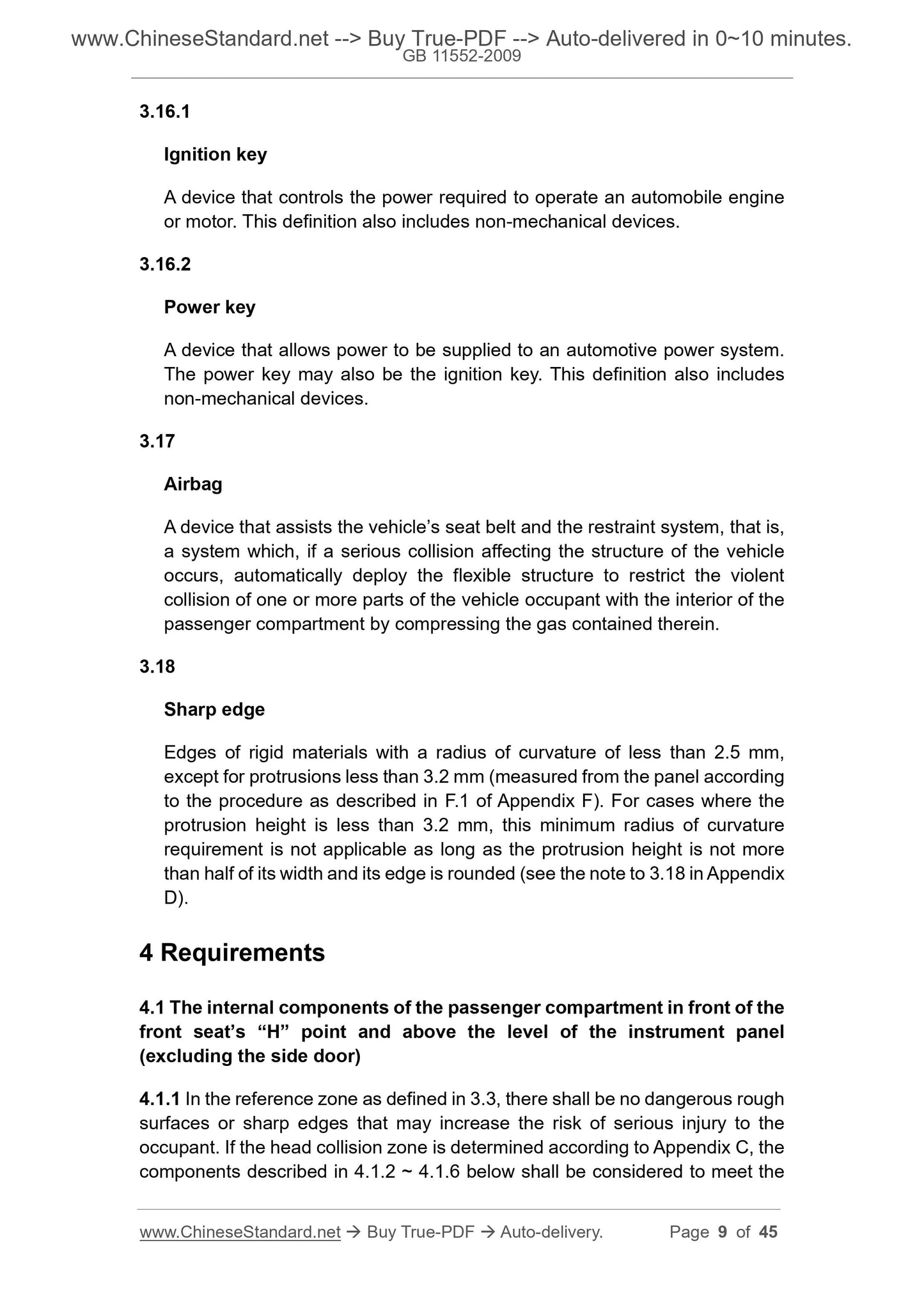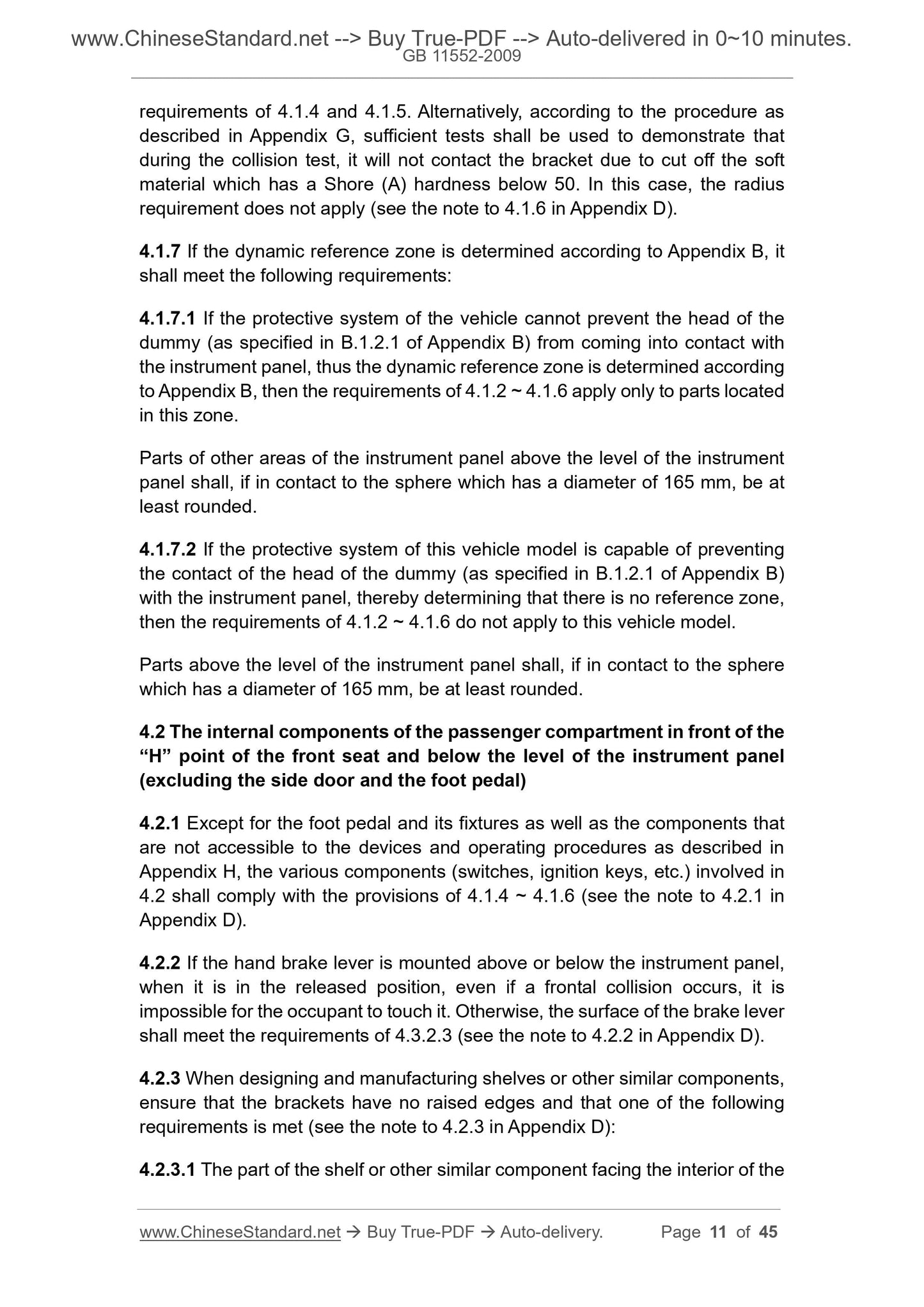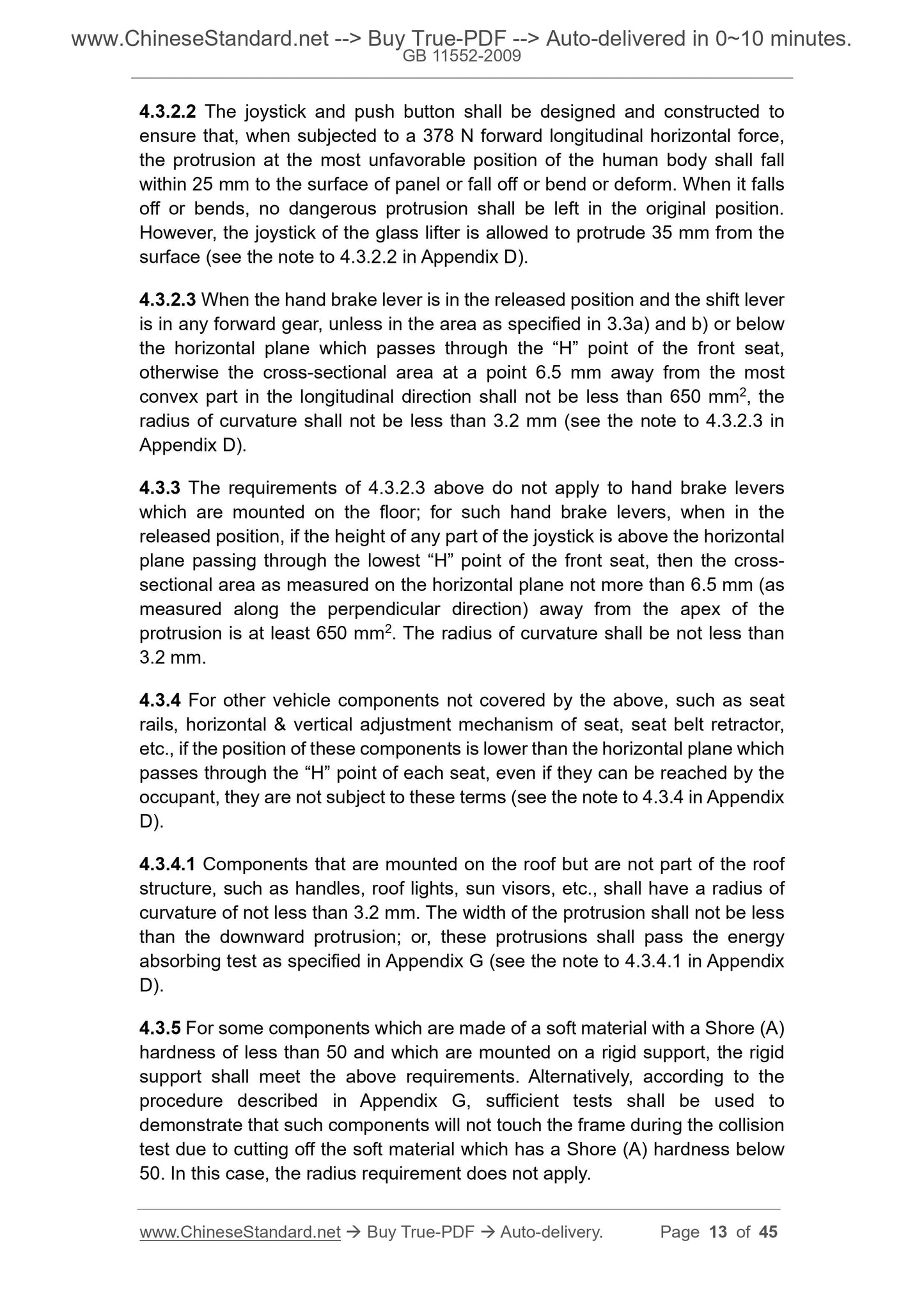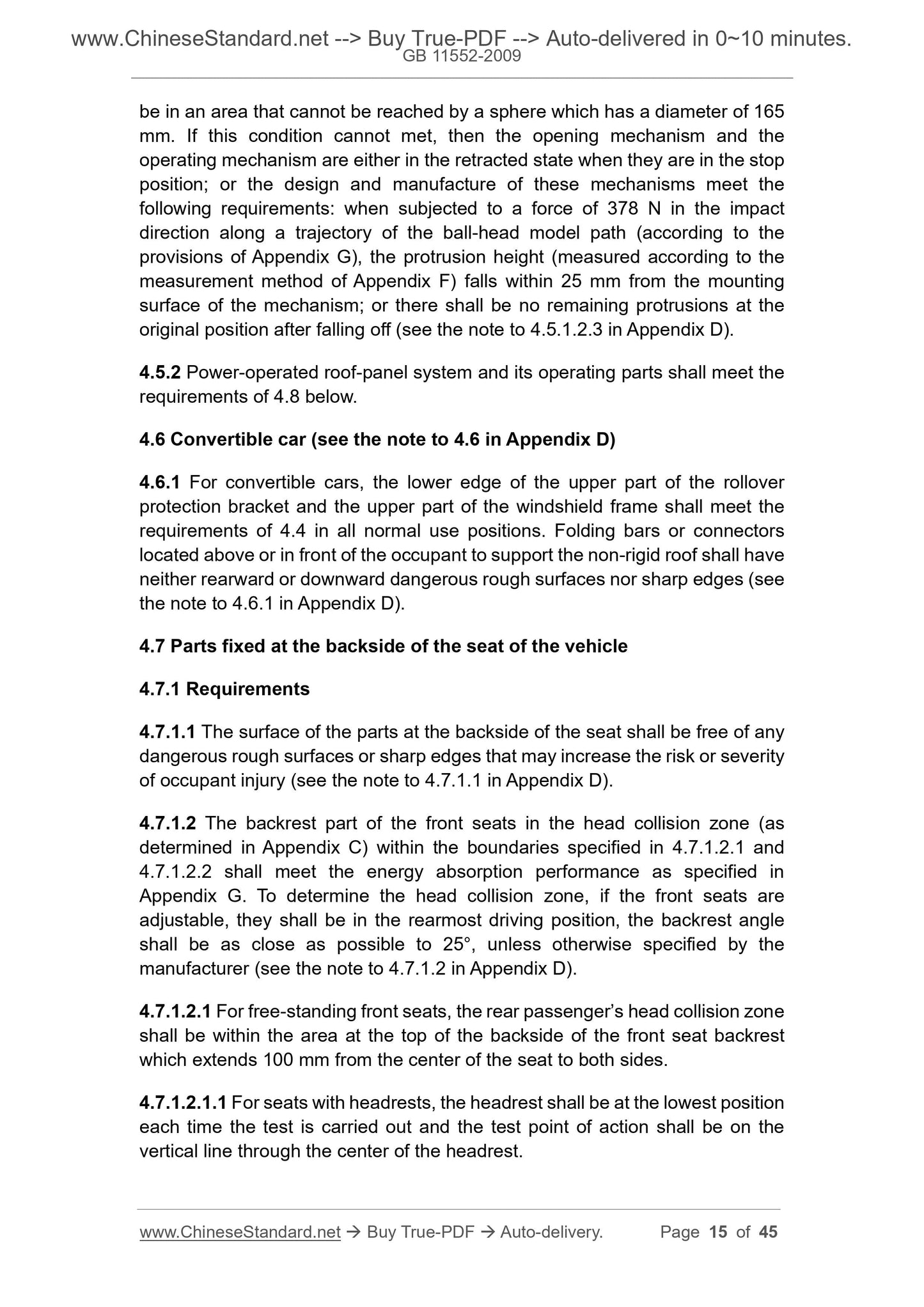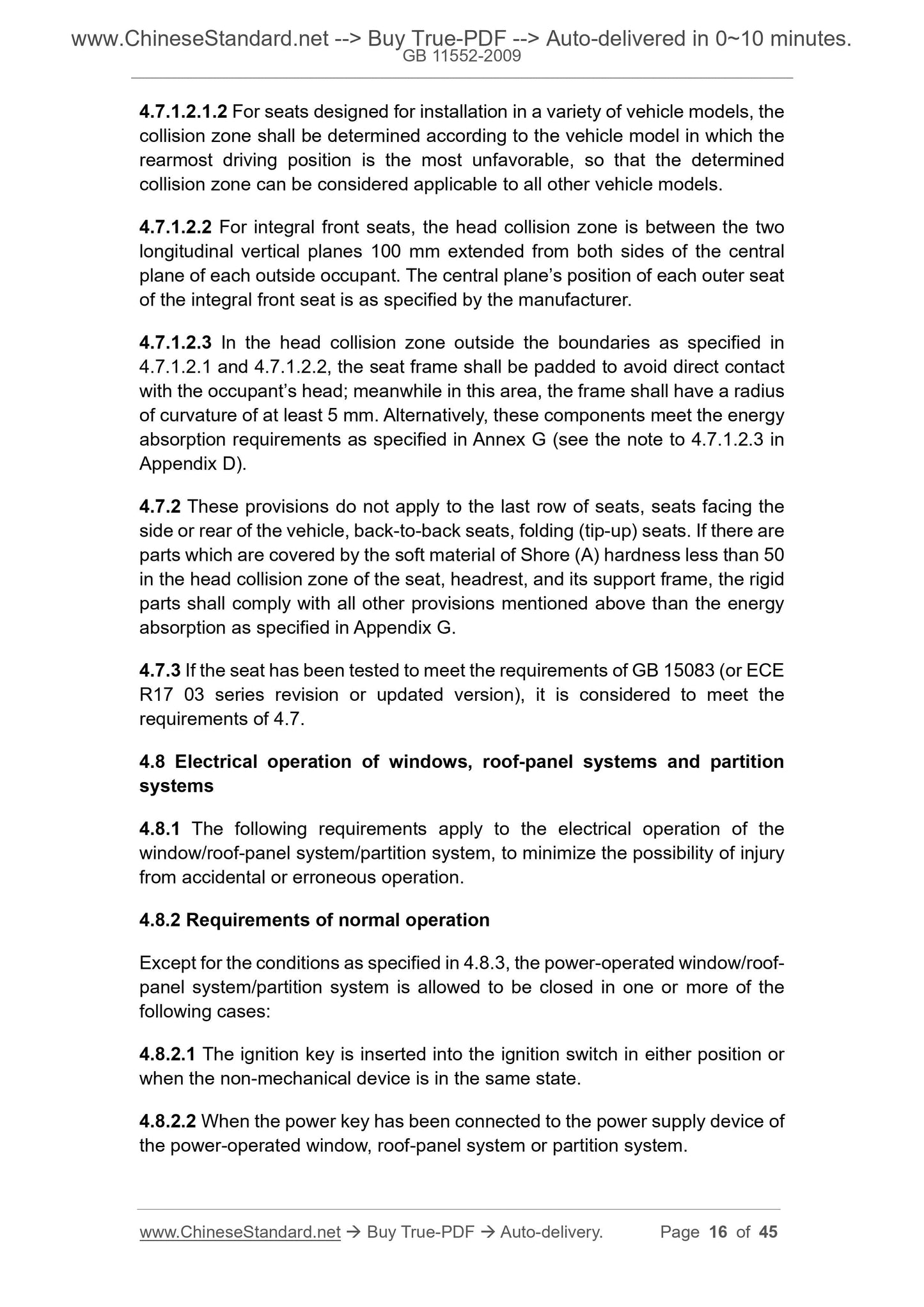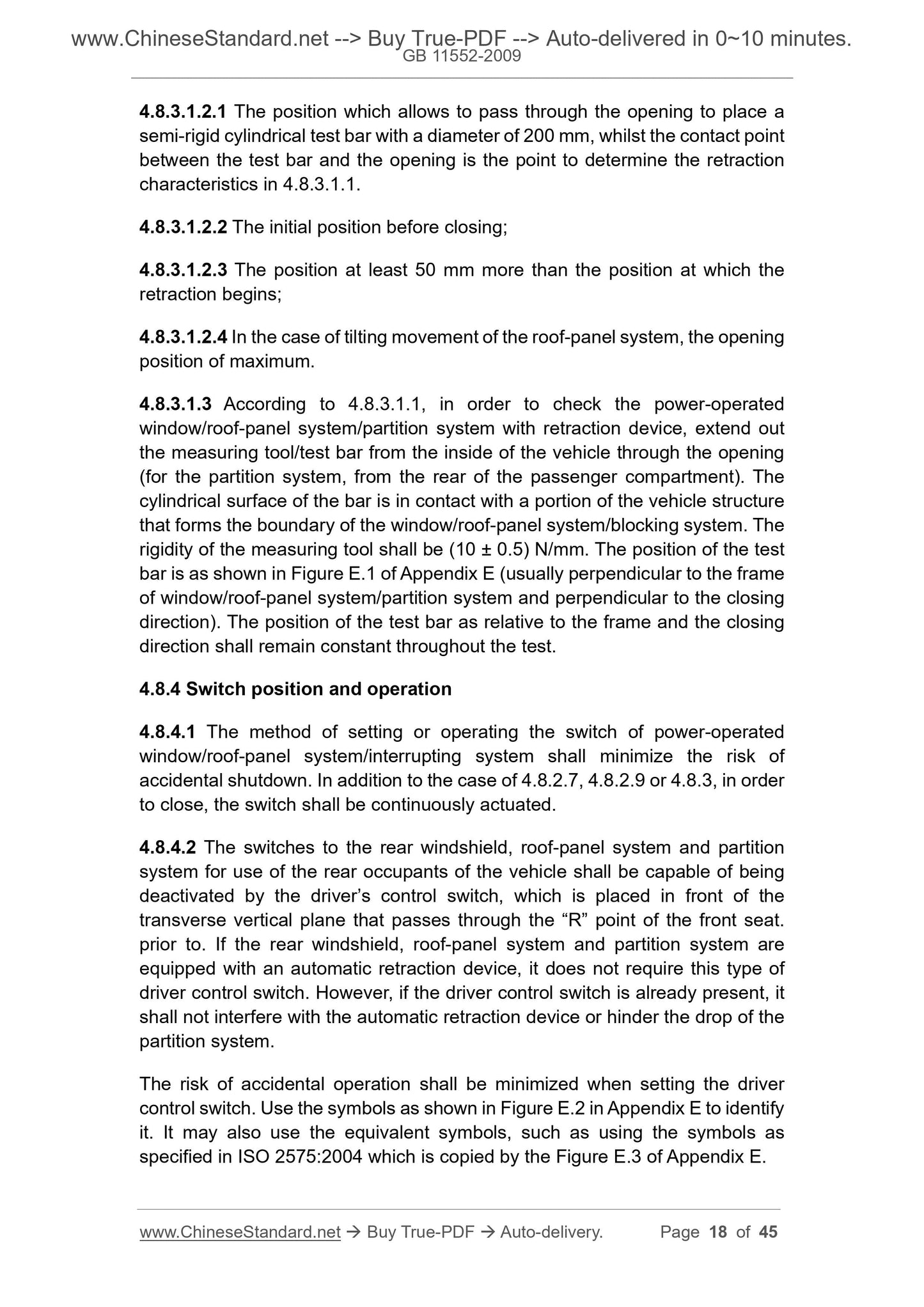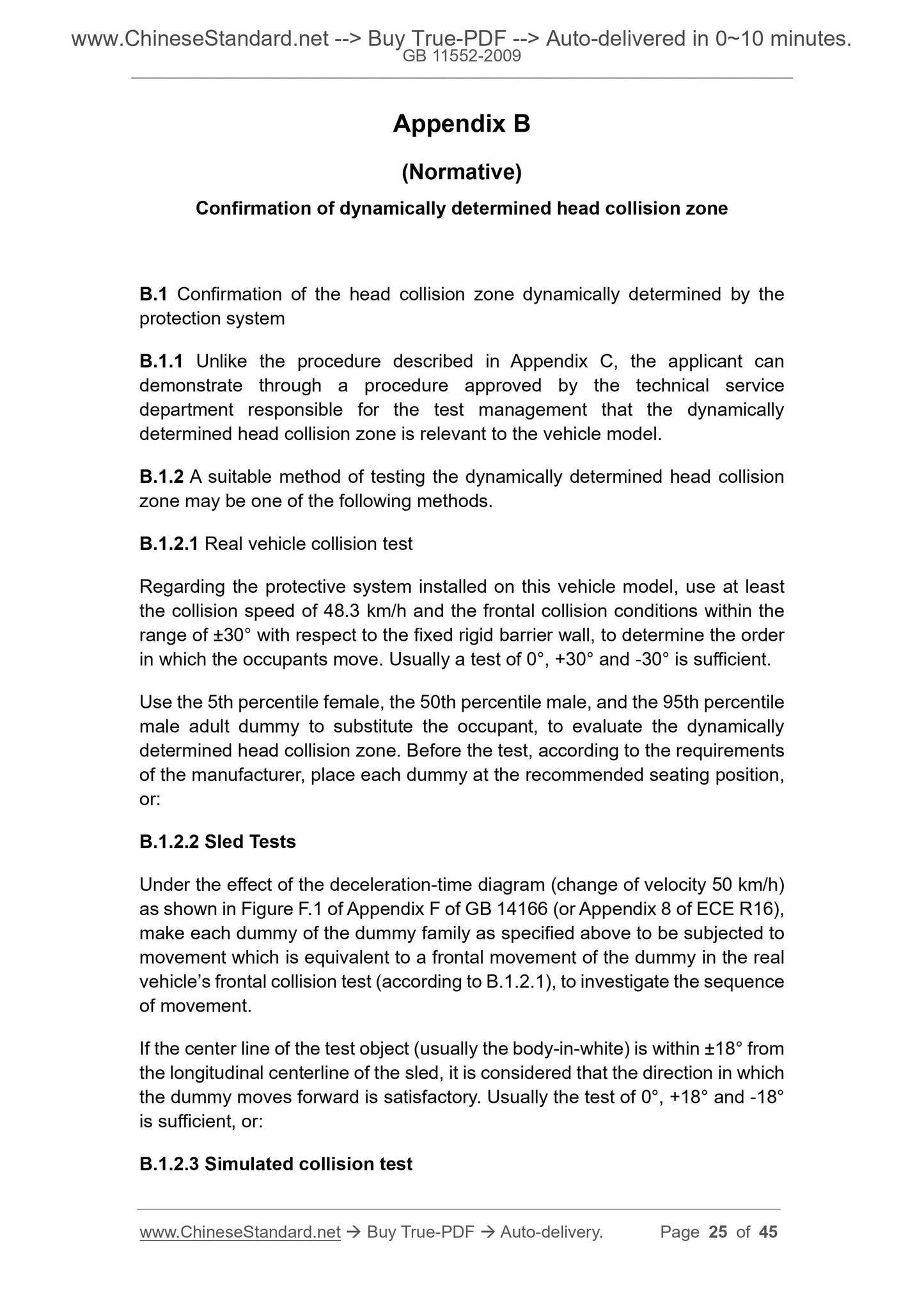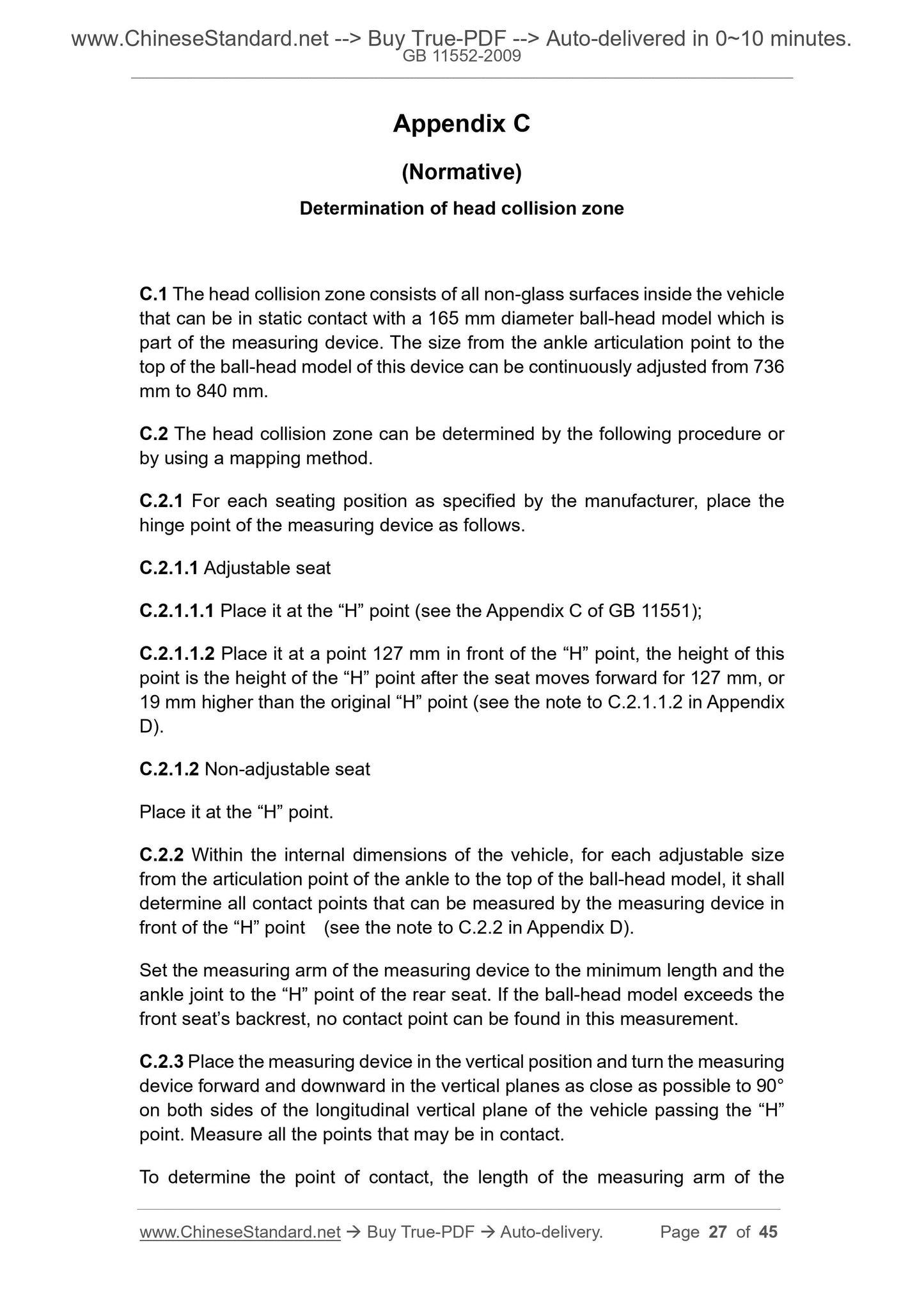1
/
su
12
PayPal, credit cards. Download editable-PDF & invoice in 1 second!
GB 11552-2009 English PDF (GB11552-2009)
GB 11552-2009 English PDF (GB11552-2009)
Prezzo di listino
$145.00 USD
Prezzo di listino
Prezzo scontato
$145.00 USD
Prezzo unitario
/
per
Spese di spedizione calcolate al check-out.
Impossibile caricare la disponibilità di ritiro
Delivery: 3 seconds. Download true-PDF + Invoice.
Get QUOTATION in 1-minute: Click GB 11552-2009
Historical versions: GB 11552-2009
Preview True-PDF (Reload/Scroll if blank)
GB 11552-2009: The interior fittings of passenger car
GB 11552-2009
GB
NATIONAL STANDARD OF THE
PEOPLE’S REPUBLIC OF CHINA
ICS 43.040.60
T 26
Replacing GB 11552-1999
The interior fittings of passenger car
ISSUED ON. SEPTEMBER 30, 2009
IMPLEMENTED ON. JANUARY 01, 2012
Issued by. General Administration of Quality Supervision, Inspection and
Quarantine;
Standardization Administration of PRC.
Table of Contents
Foreword ... 3
1 Scope ... 5
2 Normative references ... 5
3 Terms and definitions ... 5
4 Requirements ... 9
Appendix A (Informative) Comparison between the clause number of this
standard and the clause number of ECE R21 ... 21
Appendix B (Normative) Confirmation of dynamically determined head collision
zone ... 25
Appendix C (Normative) Determination of head collision zone ... 27
Appendix D (Informative) Notes to standard provisions and appendixes ... 29
Appendix E (Normative) Typical position of cylindrical test bars in the “openings”
of roof-panel system and window ... 38
Appendix F (Normative) Method of measuring the protrusion height ... 40
Appendix G (Normative) Test procedure for energy absorbing materials ... 42
Appendix H (Normative) Measuring device and procedure used in 4.2.1 ... 45
The interior fittings of passenger car
1 Scope
This standard specifies the protrusion requirements internal components of the
passenger compartment (except the internal rear-view mirror), the control unit,
the roof or the movable roof, the parts of seat back and the rear of the seat, as
well as the electrical operation requirements for the windows, roof-panel
systems and partition systems.
This standard applies to category M1 automobiles.
2 Normative references
The provisions in following documents become the provisions of this Standard
through reference in this Standard. For the dated references, the subsequent
amendments (excluding corrections) or revisions do not apply to this Standard;
however, parties who reach an agreement based on this Standard are
encouraged to study if the latest versions of these documents are applicable.
For undated references, the latest edition of the referenced document applies.
GB 11551-2003 The protection of the occupant in the event of a frontal
collision for passenger car
GB 14166 Safety belts and restraint systems for adult occupants of motor
vehicles
GB 15083 Strength requirement and test of automobile seats their
anchorages and any head restraints
ISO 2575.2004 Road vehicles - Symbols of controls, indicators and tell-tales
ISO 6487.1980 Measurement technology and testing instrument of collision
test
3 Terms and definitions
The following terms and definitions apply to this standard.
3.1
Internal fittings
The line determined by the tangent point of the vertical tangent of the
instrument panel (see the note to 3.4 in Appendix D).
3.5
Roof
The part of the top of vehicle which is surrounded by the upper edge of the
front windshield, the upper edge of the rear window, the upper frame on both
sides (see the note to 3.5 in Appendix D).
3.6
Belt line
A line formed by the lower edge of the side window of the vehicle.
3.7
Convertible car
Vehicles with no rigid parts above the belt line except for the front windshield
pillar, rollover protection brackets and/or seat belt fixing points (see the notes
to 3.5 and 3.7 in Appendix D).
3.8
Vehicle with opening roof
A vehicle with a roof or a portion thereof that can be folded back, opened, or
slid as relative to a vehicle structural component above the belt line (see the
note to 3.5 in Appendix D).
3.9
Folding (tip-up) seat
The auxiliary seat for temporary use, which is usually folded.
3.10
Protective system
Internal components and devices which are used to restrain the occupant.
3.11
Type of a protective system
A type of protection device that does not differ in the following main aspects.
3.16.1
Ignition key
A device that controls the power required to operate an automobile engine
or motor. This definition also includes non-mechanical devices.
3.16.2
Power key
A device that allows power to be supplied to an automotive power system.
The power key may also be the ignition key. This definition also includes
non-mechanical devices.
3.17
Airbag
A device that assists the vehicle’s seat belt and the restraint system, that is,
a system which, if a serious collision affecting the structure of the vehicle
occurs, automatically deploy the flexible structure to restrict the violent
collision of one or more parts of the vehicle occupant with the interior of the
passenger compartment by compressing the gas contained therein.
3.18
Sharp edge
Edges of rigid materials with a radius of curvature of less than 2.5 mm,
except for protrusions less than 3.2 mm (measured from the panel according
to the procedure as described in F.1 of Appendix F). For cases where the
protrusion height is less than 3.2 mm, this minimum radius of curvature
requirement is not applicable as long as the protrusion height is not more
than half of its width and its edge is rounded (see the note to 3.18 in Appendix
D).
4 Requirements
4.1 The internal components of the passenger compartment in front of the
front seat’s “H” point and above the level of the instrument panel
(excluding the side door)
4.1.1 In the reference zone as defined in 3.3, there shall be no dangerous rough
surfaces or sharp edges that may increase the risk of serious injury to the
occupant. If the head collision zone is determined according to Appendix C, the
components described in 4.1.2 ~ 4.1.6 below shall be considered to meet the
requirements of 4.1.4 and 4.1.5. Alternatively, according to the procedure as
described in Appendix G, sufficient tests shall be used to demonstrate that
during the collision test, it will not contact the bracket due to cut off the soft
material which has a Shore (A) hardness below 50. In this case, the radius
requirement does not apply (see the note to 4.1.6 in Appendix D).
4.1.7 If the dynamic reference zone is determined according to Appendix B, it
shall meet the following requirements.
4.1.7.1 If the protective system of the vehicle cannot prevent the head of the
dummy (as specified in B.1.2.1 of Appendix B) from coming into contact with
the instrument panel, thus the dynamic reference zone is determined according
to Appendix B, then the requirements of 4.1.2 ~ 4.1.6 apply only to parts located
in this zone.
Parts of other areas of the instrument panel above the level of the instrument
panel shall, if in contact to the sphere which has a diameter of 165 mm, be at
least rounded.
4.1.7.2 If the protective system of this vehicle model is capable of preventing
the contact of the head of the dummy (as specified in B.1.2.1 of Appendix B)
with the instrument panel, thereby determining that there is no reference zone,
then the requirements of 4.1.2 ~ 4.1.6 do not apply to this vehicle model.
Parts above the level of the instrument panel shall, if in contact to the sphere
which has a diameter of 165 mm, be at least rounded.
4.2 The internal components of the passenger compartment in front of the
“H” point of the front seat and below the level of the instrument panel
(excluding the side door and the foot pedal)
4.2.1 Except for the foot pedal and its fixtures as well as the components that
are not accessible to the devices and operating procedures as described in
A...
Get QUOTATION in 1-minute: Click GB 11552-2009
Historical versions: GB 11552-2009
Preview True-PDF (Reload/Scroll if blank)
GB 11552-2009: The interior fittings of passenger car
GB 11552-2009
GB
NATIONAL STANDARD OF THE
PEOPLE’S REPUBLIC OF CHINA
ICS 43.040.60
T 26
Replacing GB 11552-1999
The interior fittings of passenger car
ISSUED ON. SEPTEMBER 30, 2009
IMPLEMENTED ON. JANUARY 01, 2012
Issued by. General Administration of Quality Supervision, Inspection and
Quarantine;
Standardization Administration of PRC.
Table of Contents
Foreword ... 3
1 Scope ... 5
2 Normative references ... 5
3 Terms and definitions ... 5
4 Requirements ... 9
Appendix A (Informative) Comparison between the clause number of this
standard and the clause number of ECE R21 ... 21
Appendix B (Normative) Confirmation of dynamically determined head collision
zone ... 25
Appendix C (Normative) Determination of head collision zone ... 27
Appendix D (Informative) Notes to standard provisions and appendixes ... 29
Appendix E (Normative) Typical position of cylindrical test bars in the “openings”
of roof-panel system and window ... 38
Appendix F (Normative) Method of measuring the protrusion height ... 40
Appendix G (Normative) Test procedure for energy absorbing materials ... 42
Appendix H (Normative) Measuring device and procedure used in 4.2.1 ... 45
The interior fittings of passenger car
1 Scope
This standard specifies the protrusion requirements internal components of the
passenger compartment (except the internal rear-view mirror), the control unit,
the roof or the movable roof, the parts of seat back and the rear of the seat, as
well as the electrical operation requirements for the windows, roof-panel
systems and partition systems.
This standard applies to category M1 automobiles.
2 Normative references
The provisions in following documents become the provisions of this Standard
through reference in this Standard. For the dated references, the subsequent
amendments (excluding corrections) or revisions do not apply to this Standard;
however, parties who reach an agreement based on this Standard are
encouraged to study if the latest versions of these documents are applicable.
For undated references, the latest edition of the referenced document applies.
GB 11551-2003 The protection of the occupant in the event of a frontal
collision for passenger car
GB 14166 Safety belts and restraint systems for adult occupants of motor
vehicles
GB 15083 Strength requirement and test of automobile seats their
anchorages and any head restraints
ISO 2575.2004 Road vehicles - Symbols of controls, indicators and tell-tales
ISO 6487.1980 Measurement technology and testing instrument of collision
test
3 Terms and definitions
The following terms and definitions apply to this standard.
3.1
Internal fittings
The line determined by the tangent point of the vertical tangent of the
instrument panel (see the note to 3.4 in Appendix D).
3.5
Roof
The part of the top of vehicle which is surrounded by the upper edge of the
front windshield, the upper edge of the rear window, the upper frame on both
sides (see the note to 3.5 in Appendix D).
3.6
Belt line
A line formed by the lower edge of the side window of the vehicle.
3.7
Convertible car
Vehicles with no rigid parts above the belt line except for the front windshield
pillar, rollover protection brackets and/or seat belt fixing points (see the notes
to 3.5 and 3.7 in Appendix D).
3.8
Vehicle with opening roof
A vehicle with a roof or a portion thereof that can be folded back, opened, or
slid as relative to a vehicle structural component above the belt line (see the
note to 3.5 in Appendix D).
3.9
Folding (tip-up) seat
The auxiliary seat for temporary use, which is usually folded.
3.10
Protective system
Internal components and devices which are used to restrain the occupant.
3.11
Type of a protective system
A type of protection device that does not differ in the following main aspects.
3.16.1
Ignition key
A device that controls the power required to operate an automobile engine
or motor. This definition also includes non-mechanical devices.
3.16.2
Power key
A device that allows power to be supplied to an automotive power system.
The power key may also be the ignition key. This definition also includes
non-mechanical devices.
3.17
Airbag
A device that assists the vehicle’s seat belt and the restraint system, that is,
a system which, if a serious collision affecting the structure of the vehicle
occurs, automatically deploy the flexible structure to restrict the violent
collision of one or more parts of the vehicle occupant with the interior of the
passenger compartment by compressing the gas contained therein.
3.18
Sharp edge
Edges of rigid materials with a radius of curvature of less than 2.5 mm,
except for protrusions less than 3.2 mm (measured from the panel according
to the procedure as described in F.1 of Appendix F). For cases where the
protrusion height is less than 3.2 mm, this minimum radius of curvature
requirement is not applicable as long as the protrusion height is not more
than half of its width and its edge is rounded (see the note to 3.18 in Appendix
D).
4 Requirements
4.1 The internal components of the passenger compartment in front of the
front seat’s “H” point and above the level of the instrument panel
(excluding the side door)
4.1.1 In the reference zone as defined in 3.3, there shall be no dangerous rough
surfaces or sharp edges that may increase the risk of serious injury to the
occupant. If the head collision zone is determined according to Appendix C, the
components described in 4.1.2 ~ 4.1.6 below shall be considered to meet the
requirements of 4.1.4 and 4.1.5. Alternatively, according to the procedure as
described in Appendix G, sufficient tests shall be used to demonstrate that
during the collision test, it will not contact the bracket due to cut off the soft
material which has a Shore (A) hardness below 50. In this case, the radius
requirement does not apply (see the note to 4.1.6 in Appendix D).
4.1.7 If the dynamic reference zone is determined according to Appendix B, it
shall meet the following requirements.
4.1.7.1 If the protective system of the vehicle cannot prevent the head of the
dummy (as specified in B.1.2.1 of Appendix B) from coming into contact with
the instrument panel, thus the dynamic reference zone is determined according
to Appendix B, then the requirements of 4.1.2 ~ 4.1.6 apply only to parts located
in this zone.
Parts of other areas of the instrument panel above the level of the instrument
panel shall, if in contact to the sphere which has a diameter of 165 mm, be at
least rounded.
4.1.7.2 If the protective system of this vehicle model is capable of preventing
the contact of the head of the dummy (as specified in B.1.2.1 of Appendix B)
with the instrument panel, thereby determining that there is no reference zone,
then the requirements of 4.1.2 ~ 4.1.6 do not apply to this vehicle model.
Parts above the level of the instrument panel shall, if in contact to the sphere
which has a diameter of 165 mm, be at least rounded.
4.2 The internal components of the passenger compartment in front of the
“H” point of the front seat and below the level of the instrument panel
(excluding the side door and the foot pedal)
4.2.1 Except for the foot pedal and its fixtures as well as the components that
are not accessible to the devices and operating procedures as described in
A...
Share
